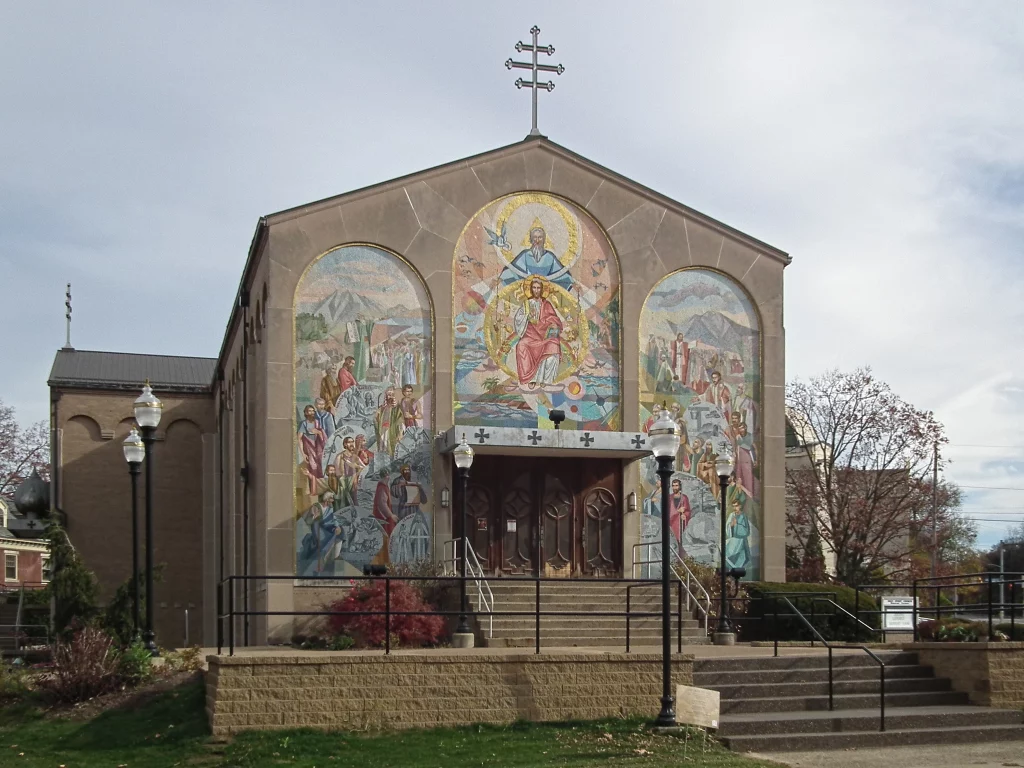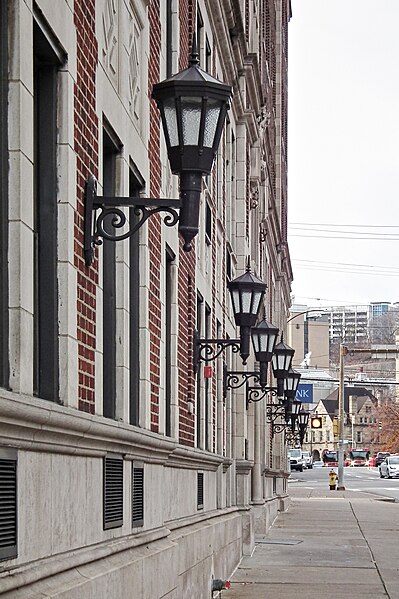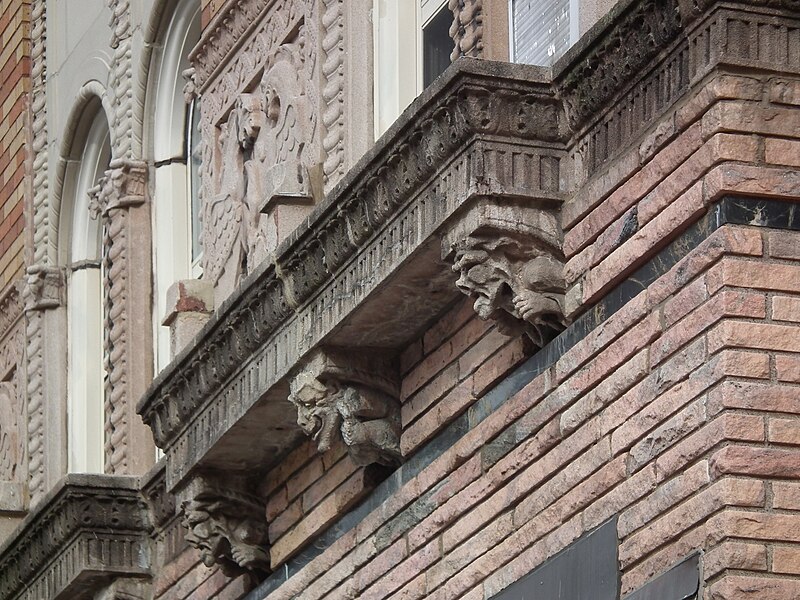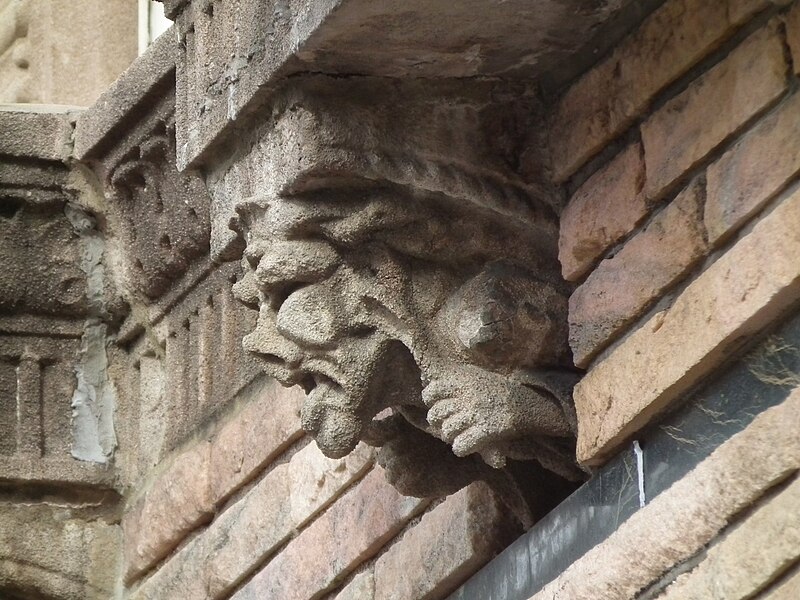


Begun in 1960 and dedicated in 1962, this church was designed by the firm of Williams, Tribilcock, Whitehead and Associates1 in a modernist Byzantine style. And no one notices the architecture, because the church is deliberately oriented to display its huge and colorful mosaic triptych, “made entirely of genuine Venetian glass,” to traffic outbound on Fifth Avenue.

The mosaic is a complete introduction to Christian theology. On the left, the Old Testament prophets who foretold Christ, with illustrations of their lives and visions; on the right, the Apostles who knew and were taught by Christ, with equally appropriate symbols; and in the center, the Trinity, up among the birds and airplanes.


The mosaic has suffered some cracking over the years, but it is still a stunningly colorful sight to come across as one walks from Oakland toward Shadyside.

The south-transept entrance features three aluminum-glazed onion domes served on an hors-d’œuvre tray.
On city planning maps, the church is in Shadyside, but Pittsburghers have always considered the Oakland monumental district to begin at Rodef Shalom at the eastern end, and the church calls its neighborhood “Oakland,” and the post office places it in the Oakland postal code.

One of our grandest apartment buildings, the Fairfax just got a thorough going-over. It was opened in 1927 as the Fifth Avenue Apartments, but changed its name with its ownership a year later and has been the Fairfax ever since. The architect was Philip Morison Jullien from Washington (that’s Big Worshington to Picksburghers from the South Hills), who also gave us the Arlington Apartments.

The architectural style is sometimes referred to as “Jacobethan,” meaning that it takes inspiration from the long period of the reigns of Elizabeth I and James I, without being too pedantic about the exact period.

This Jacobean Gothic arch is about as broad as it can be and still qualify as an arch.





The perspective above is impossible. There is no place to stand far away enough to get a natural-looking perspective view of the Fairfax. The lens had to be at a very wide angle to capture the whole building, which created what photography critics of a century ago would have called “violent perspective.” Father Pitt has made some intricate adjustments, at the cost of some distortion of individual objects like the cars on the street, to create a more natural-looking view of the sort Mr. Jullien might have given the client in his perspective rendering. In fact, different parts of the picture are at different perspectives, and if you look closely you can see the seam running down through the blue car toward the right.

Of all the buildings on the Carnegie Mellon campus, Margaret Morrison Carnegie Hall (named for Andrew Carnegie’s mother) probably makes the most jaw-dropping first impression. It was originally built in 1907 as a separate but related school, the Margaret Morrison Carnegie School for Women, where women would learn the skills women were fitted to learn. When it was discovered that women were fitted to learn everything, the school dissolved into the larger university.
Henry Hornbostel’s design makes its opening statement with a grand and stripey rotunda that is impressive and welcoming at the same time.


The polychrome ornament found throughout the campus is laid on lavishly here.

One of the sconces in the rotunda.

A side porch with some unusually intricate decoration that nevertheless does not look at all fussy.

Built in 1929, this eight-storey apartment tower has a newer ninth floor sheathed in what appears to be corrugated metal. Father Pitt has some advice for architects contemplating asymmetrical additions with cheap materials to symmetrical Renaissance palaces like this:

Like several other apartment buildings in the area, this one is festooned with grotesque whimsies.







The rear section has a bay rising the entire height of the building, with a corrugated-metal hat on top.
Addendum: A kind correspondent has found an advertisement for the Dithridge Apartments when they were new, which supplies us with a definite date (1929; they were to be ready for occupancy in April) and shows us the building as it looked before the top was altered.


Mark A. Nordenberg Hall, built in 2011, is a perfect example of what old Pa Pitt calls the neoneoclasssical style: it uses the shapes and symmetry of classical architecture without the embarrassing ornamentation. In this building, some of the effect of that missing classical ornamentation is simulated by a pleasing variation in the materials. The architects were the St. Louis firm of Mackey Mitchell Architects, with our own MCF Architecture (the successors to Edward Stotz) coming along for the ride.
This building replaced the 1926 University Place Office Building by Edward B. Lee, a much smaller building that, in its sparse detailing, almost anticipated the neoneoclassical style.

Built in 1907, this Jacobean palace was the work of John T. Comès. We happen to know that it was roofed with McClure’s Genuine Charcoal Iron Re-Dipped Roofing Tin, because in a 1910 advertisement that company proudly reproduced the architect’s perspective rendering of the building:

Notice in the rendering that Comès has drawn sections of tapestry brick, which is typical of his work—if he was going to use brick, he was going to use it to its full decorative potential. Either he was overruled by the client or he changed his mind, because the building as it stands is just ordinary red brick in Flemish stretcher bond, with stone trim for decoration.

The building is now the St. Joan of Arc Building of Oakland Catholic High School, and the Trib has a story from 2013 about the renovations to the St. Joan of Arc Building to bring it into the early twenty-first century.

